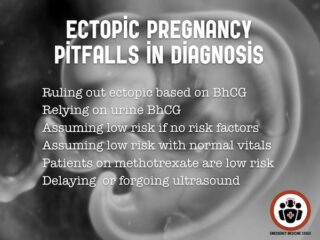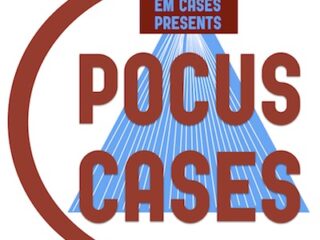Ultrasound
BCE 68 Ectopic Pregnancy Pitfalls in Diagnosis
This month's EM Cases Best Case Ever podcast features Dr. Catherine Varner, Emergency Physician at Sinai Health System and researcher at Schwartz-Reisman Emergency Medicine Institute (SREMI) discussing the key pitfalls in the diagnosis of ectopic pregnancy and ruptured ectopic pregnancy. It turns out that we're missing the diagnosis more than we'd like to admit. Dr. Varner debunks much of the traditional teaching around ectopic pregnancy so that we can improve our diagnostic skills for this potentially life threatening diagnosis...
POCUS Cases Video Series has Launched!
The long wait has been well worth it. The EM Cases POCUS Cases Video Series has officially been launched! POCUS Cases is an original EM Cases video series led by Dr. Robert Simard, an Emergency Physician at North York General Hospital and Sunnybrook Health Sciences Centre in Toronto. Rob always wished he had x-ray vision…but since he possesses no special powers…using Point-of-Care Ultrasound (POCUS) is the next closest thing. He completed a POCUS fellowship at NOSM and teaches POCUS nationally and internationally. He is the creator POCUS Cases, an original EM cases screencast that provides POCUS clinical pearls in an engaging and fun way that will help you provide stellar care to your patients...
Episode 96 Beyond ACLS Cardiac Arrest – Live from EMU Conference 2017
This is the first ever video podcast on EM Cases with Jordan Chenkin from EMU Conference 2017 discussing how to optimize three aspects of cardiac arrest care: persistent ventricular fibrillation, optimizing pulse checks and PEA arrest, with code team videos contrasting the ACLS approach to an optimized approach...
Episode 82 – Emergency Radiology Controversies
EM Cases Episode 82 Emergency Radiology Controversies, pearls and pitfalls: Which patients with chest pain suspected of ACS require a CXR? What CXR findings do ED docs tend to miss? How should we workup solitary pulmonary nodules found on CXR or CT? Is the abdominal x-ray dead or are there still indications for it's use? Which x-ray views are preferred for detecting pneumoperitoneum? When should we consider ultrasound as a screening test instead of, or before, CT? What are the indications for contrast in abdominal and head CT? How should we manage the patient who has had a previous CT contrast reaction who really needs a CT with contrast? What is the truth about CT radiation for shared decision making? And much more...
BEEM Cases 2 – Renal Colic Imaging, Analgesia, Fluids & Medical Expulsive Therapy
Urolithiasis is one of the more frequent diagnoses we are faced with in the Emergency Department, with an estimated 1 million ED visits due to renal colic. As such we are tasked with its diagnosis, prognosis and treatment. The following is a brief summation of the evidence regarding some of the most frequent questions encountered when diagnosing and managing urolithiasis. Four questions are answered by Rory Spiegel on this BEEM Cases. What is the optimal initial imaging modality for the diagnostic work-up of urolithiasis? Once the diagnosis of renal colic has been made what is the most efficacious analgesic strategy? Is there clinical utility to IV fluid administration in the management of renal colic? What is the use of medical expulsion therapy in the management of urolithiasis?
Best Case Ever 45 – Mike Winters on Cardiac Arrest
I had the great pleasure of meeting Dr. Mike Winters on his first ever visit to Canada at North York General's Emergency Medicine Update Conference, where he gave two fantastic presentations. His credentials are impressive: He is the Medical Director of the Emergency Department, Associate Professor in both EM and IM, EM-IM-Critical Care Program co-director and Residency Program Director of EM-IM at the University of Maryland in Baltimore. Sometimes we are so caught up with the job we need to get done during cardiac arrest that we forget about the important and profound effect that this event has on patients' families. On this Best Case Ever Dr. Winters tells the story of witnessing his grandfather's cardiac arrest, being present in the ED during the resuscitation attempts, and how that experience has coloured his practice. We discuss some pearls on communication with patients' families after death, colour-coded cardiac arrest teams and how to integrate POCUS into cardiac arrest care while minimizing chest compressions.







